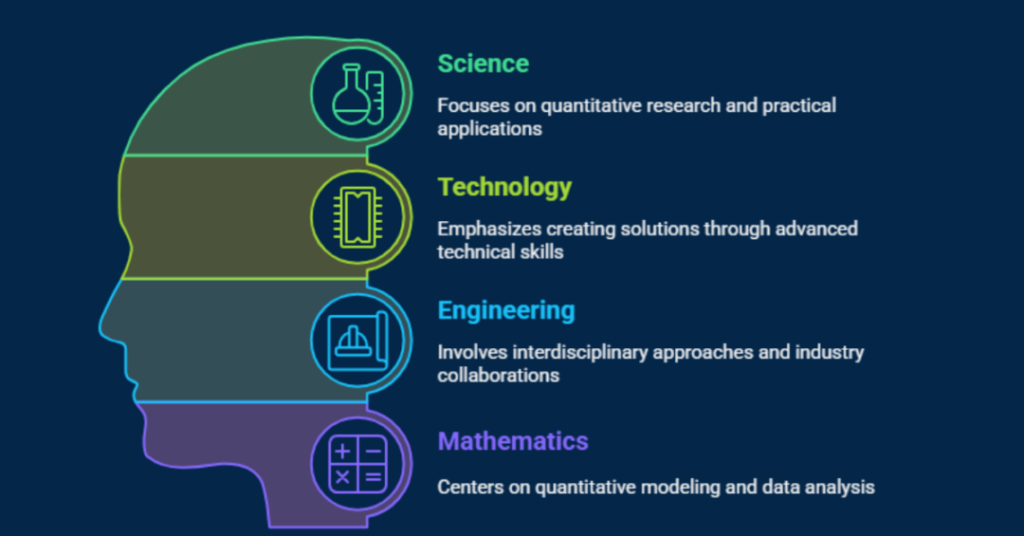13 June 2025
4 minutes read
What Are Graduate STEM Programs? What You Can Do With One?

Key Takeaways
- Graduate STEM programs aren’t equal – only DHS-designated ones qualify international students for 36-month OPT extensions versus 12 months
- Science, Technology, Engineering, and Mathematics degrees offer different pathways, with interdisciplinary approaches being more valuable than single-focus programs
- STEM graduates access exclusive immigration benefits, priority funding, and high-demand roles in emerging fields paying six figures immediately
Nearly 40% of international F-1 students choose STEM programs – yet most pick wrong. You’re confused about which graduate programs qualify as STEM-designated by the Department of Homeland Security, whether your engineering or mathematics degree earns 36-month OPT extension versus 24-month OPT, and if employers actually hire from your field.
Reality check: not all technology, math, or STEM MBA programs qualify for Optional Practical Training extensions – students discover this after admission. Choose STEM-designated graduate programs that match technical employer demands, understand undergraduate versus graduate requirements, and pick concentrations offering full-time certificate paths.
What Are The 4 Types Of STEM Degrees?
Think all STEM degrees are created equal? The Department of Homeland Security recognizes over 400 STEM education programs, but only specific degree programs qualify international students for that OPT STEM extension – 36 months instead of 12 months post-completion OPT.

Most assume any STEM graduate program gets STEM designation, but one wrong choice costs you years of work authorization.
Science-Based STEM Degrees
Science STEM-designated degrees focus on quantitative research and practical applications. These graduate STEM programs emphasize specialized STEM skills in emerging fields, offering direct pathways to STEM jobs. STEM graduate students find these designated programs valuable because they combine theoretical knowledge with entrepreneurship components that create real value for international graduates to remain eligible for extended authorization.
Technology STEM Degrees
Technology STEM designated programs aren’t just programming – they’re about creating STEM solutions through advanced technical skills. Graduate school offerings include cybersecurity and AI with direct advancement paths. These degree programs provide scholar-level training and immigration benefits that STEM designation to programs offers, making students eligible for specialized STEM work authorization.
Engineering STEM Degrees
Engineering STEM-designated degrees evolved beyond traditional fields – today’s graduate degrees focus on interdisciplinary approaches combining multiple expertise areas. These doctoral and master’s programs emphasize practical applications through industry collaborations. The programs offered provide direct access to STEM jobs with technical authorization for complex roles requiring specialized STEM education and OPT extension benefits.
Mathematics STEM Degrees
Mathematics STEM-designated degrees include applied mathematics, statistics, and computational mathematics programs that go beyond theoretical concepts. These graduate STEM programs focus on quantitative modeling, data analysis, and algorithmic problem-solving that STEM fields demand. International students find these designated programs particularly valuable because they provide STEM skills applicable across multiple industries.
What Can You Do With Graduate STEM Programs?
So you think a graduate STEM degree just gets you a fancy job title and bragging rights at family dinners? Here’s the reality check: STEM graduates don’t just work in labs – they’re the ones programming algorithms that decide your Netflix recommendations, managing risk for billion-dollar companies, and conducting public research that shapes government policy.
While your liberal arts friends are still figuring out their “passion,” you’re building interdisciplinary skill sets that immigration services literally created visa extensions for because the U.S. desperately needs this expertise.
- Land high demand roles that didn’t exist five years ago – Programming and risk management coursework opens doors to emerging fields of study like AI ethics and climate data analysis paying six figures immediately
- Access exclusive scholarship and research funding – Graduate STEM students get priority for government grants and advancement programs covering tuition while building expertise in public research projects
- Qualify for immigration benefits others can’t touch – Immigration services designed visa extensions specifically for STEM fields because U.S. employment in these areas is critically needed
- Build interdisciplinary skill sets making you irreplaceable – Coursework combines technical expertise with business skills, creating the bridge between engineering teams and executives that companies desperately need
Conclusion
Look, here’s what nobody tells you about graduate STEM programs: they’re not just about getting smarter or earning more money. They’re about positioning yourself in a world where technical skills determine who gets to stay, who gets to lead, and who gets left behind.
The immigration system literally rewards STEM graduates because countries need what you’ll know. Your coursework isn’t just academic exercise – it’s training for problems that don’t have textbook solutions yet. While others debate which career path to choose, you’re building capabilities that didn’t exist when your parents went to college.
You know which STEM programs actually work. We know how to get you there. Ambitio connects you with STEM-designated programs that deliver 36-month OPT extensions and real careers. No confusion. No mistakes. Just results. Make it happen with Ambitio.
FAQs
What is a STEM graduate program?
A STEM graduate program is an advanced degree in Science, Technology, Engineering, or Mathematics, typically a master’s or doctorate, focusing on research, technical skills, and problem-solving
How are STEM programs designated?
A program is STEM-designated if at least 50% of its required courses are in STEM fields
What are the benefits of a STEM-designated degree?
Benefits include eligibility for extended work opportunities for international students (such as the 24-month OPT extension in the U.S.), broader career options, and higher demand in the job market
What types of graduate STEM degrees are available?
Common degrees include Master of Science (MS), Master of Engineering (MEng), and Doctor of Philosophy (PhD) in various STEM disciplines
What careers can I pursue with a STEM graduate degree?
Careers include research scientist, engineer, data scientist, college professor, technology manager, and more
How long does it take to complete a STEM graduate program?
Master’s degrees typically take 1–3 years; PhDs usually require at least 4–5 years

You can study at top universities worldwide!
Get expert tips and tricks to get into top universities with a free expert session.
Book Your Free 30-Minute Session Now! Book a call now




























